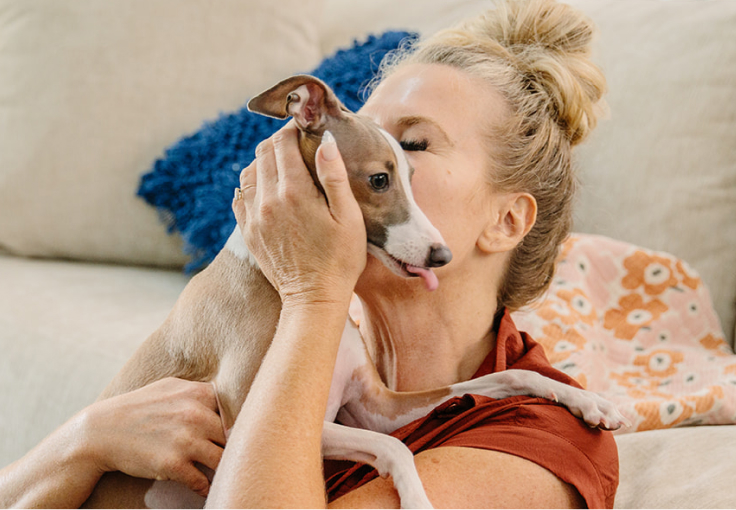Nom Nom Blog
We're Here for Dog Parents: How to Nurture the Person/Pup Bond
Dog parents go the extra mile to support their pup’s needs, from satisfying their nutritional requirements and taste preferences, to obediently fetching their ball—again and again—from under the couch. That’s because they’re consciously tuning in to their pup’s unique ways of expressing themselves, and responding with clarity and empathy.
And just as with human children, it's essential for dog parents to set a good example. “Do as I say, not as I do” simply isn’t going to cut it with dogs. Being that your pup largely communicates physically, your own body language and behavior speaks volumes, and plays a crucial role in how your dog perceives and responds to you.
Want to learn more about how to clearly communicate with your pup? We’re here for you, dog (parents).
HOW TO RELATE TO YOUR DOG
KEEP A CALM AND CONFIDENT POSTURE
-
Stand Tall: Standing tall and relaxed conveys confidence and leadership. Avoid slouching or tensing up, as this can signal uncertainty or stress.
-
Slow Movements: Move slowly and deliberately to avoid startling your dog. Sudden, jerky movements can cause anxiety or excitement.
USE APPROACHABLE SIGNALS
-
Squat Down: When you want to encourage your dog to come to you, squat down to their level. This makes you appear more approachable and less intimidating.
-
Open Arms: Open your arms slightly to the sides, palms facing up, to invite your dog in for a hug or petting. Avoid hovering directly over them, as this can be perceived as threatening.
PAIR COMMANDS WITH GESTURES
-
Hand Signals: Combine verbal commands with hand signals. For instance, use an open palm facing up for “sit” and a sweeping motion downward for “lie down.” This reinforces the command and makes it easier for your dog to understand.
-
Pointing: Pointing can be effective for directing your dog’s attention. Pointing towards a toy or treat helps guide their focus.
PAY ATTENTION TO TONE
-
Firm but Gentle: Use a firm but gentle tone for commands. This conveys authority without being harsh. For example, a clear and steady “sit” is more effective than a loud or high-pitched command.
-
Consistent Words: Stick to simple, consistent words for commands. Dogs respond best to short, clear words like “sit,” “stay,” “come,” and “no.”
OFFER PRAISE & ENCOURAGEMENT
-
High-Pitched Praise: A higher-pitched, enthusiastic tone is great for praise. For example, saying “good girl!” or “yes!” in a happy, upbeat voice reinforces positive behavior.
-
Calm Reassurance: Use a soft, soothing tone to reassure your dog when they’re anxious or scared. Phrases like “it’s okay” or “good boy” said calmly can help comfort them.
_______________________________________________________________________________________________________________________________________
HOW TO HELP YOUR DOG REACH NEW HEIGHTS
Want your pup to get straight A’s in social interactions and best boy/girl behavior? You’re gonna have to get off the couch — if you don’t want them chewing holes in it through sheer boredom and frustration.
TEACH NEW COMMANDS
-
Pairing Signals: When teaching a new command, pair the verbal cue with a hand signal. For instance, say “sit” while raising your hand with the palm open and facing up.
-
Repetition: Consistently use the same combination of vocal and physical signals until your dog understands the command.
REINFORCE POSITIVE BEHAVIOR
-
Praise with Touch: Combine vocal praise with gentle petting or a treat. For example, say “good boy” while giving a gentle pat or scratch behind the ears.
-
Encourage Engagement: Use your body to compel them to come to you. Lean forward slightly and use a happy tone to call your dog to you for play or training.
MANAGE MISBEHAVIOR
-
Interrupt and Redirect: If your dog is exhibiting unwanted behaviors, use a firm “no” combined with a stop gesture (like raising your hand with the palm facing out). Then, redirect their attention to a desired behavior with a neutral tone and guiding hand signal.
-
Patience and Repetition: Dogs learn through steady routines. Give them time to understand and respond to your cues.
______________________________________________________________________________________________________________________________________
HOW TO BUILD A RELATIONSHIP WITH YOUR DOG
Communication isn’t just about commands, it's about connecting on a deeper level.
Learn Their Love Language: Figure out what makes them tick, whether it’s physical touch or receiving gifts (such as access to your side of the bed).
Spend Quality Time Together: Form a united front through regular one-on-one time, including playdates, walks and shared activities.
Give Them Space: Respect their boundaries, especially when they are eating, hiding or sleeping…even if they don’t respect yours. This builds trust with your pup.
Understand Their Needs: Your dog’s breed (or mix) can tell you a lot about what kind of exercise they might enjoy. Plan enrichment activities that make the most of your pup’s natural instincts, from herding to guardwork to cuddling together on the couch (hey, it’s a skill).
Exercise Their Mind: Mental exercise is key to a dog’s overall health and happiness. It prevents boredom, improves cognitive function, and creates an opportunity to bond with their favorite people. Check out this post for mental activity tips.
______________________________________________________________________________________________________________________________________
Communicating with your dog involves understanding their signals, using clear and consistent cues, and building a relationship based on trust and respect. By paying attention to how you relate to them, and helping to enrich their lives through activities, exercise, and most of all, attention and time, you can deepen your bond and ensure a harmonious coexistence.
Remember, the key to successful communication is empathy and patience, as well as a genuine desire to meaningfully connect with your dog.


